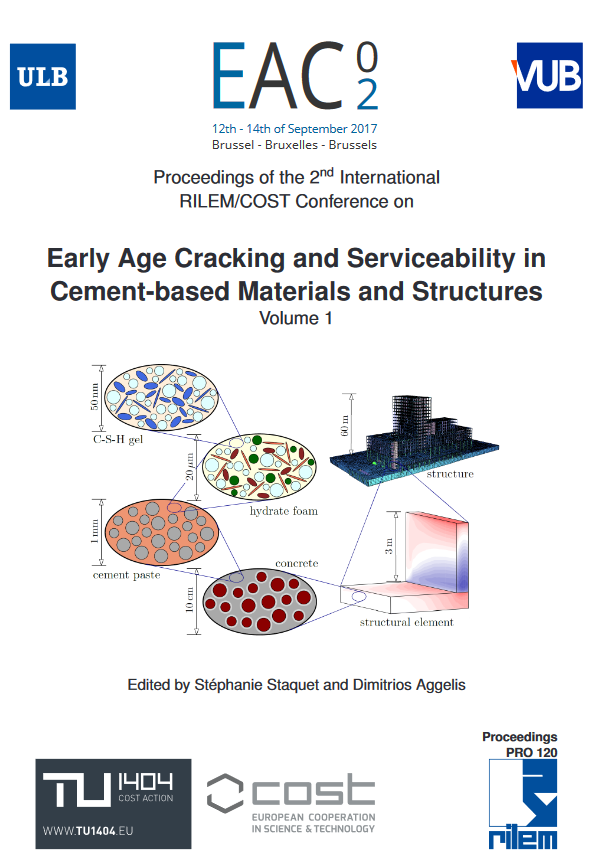Publications
Proceedings pro120-1 : 2nd International RILEM/COST Conference on Early Age Cracking and Serviceability in Cement-based Materials and Structures (Vol 1)
We are honored to organize and host the 2nd International RILEM/COST Conference on Early Age Cracking and Serviceability in Cement-based Materials and structures EAC-02, 12-14 September 2017 in Brussels in Belgium in conjunction of the annual scientific meeting of the COST Action TU1404 (http://www.tu1404.eu). The conference is scientifically endorsed by RILEM. This COST Action TU1404 is entitled: “Towards the next generation of standards for service life of cement-based materials and structures”, dedicated to assist deepening knowledge regarding the service life behavior of cement-based materials and structures. The main purpose of this Action is to bring together relevant stakeholders (experimental and numerical researchers, standardization offices, manufacturers, designers, contractors, owners and authorities) in order to reflect today’s state of knowledge in new guidelines/recommendations, introduce new products and technologies to the market, and promote international and inter-speciality exchange of new information, creating avenues for new developments. The COST Action TU1404 is basically divided in three main workgroups targeted to: WG 1 – Testing of cement-based materials and RRT+WG 2 – Modelling and benchmarking WG 3 – Recommendations and productsAlso, two important instruments of the Action are under way: the Extended RoundRobin Testing Program (RRT+) and the numerical benchmarking. The RRT+ is currently involving 42 enrolled laboratories. This International RILEM/COST Conference follows the RILEM InternationalConference on Early Age Cracking in Cementitious Systems (EAC’01) organized in March, 2001, in Haifa, Israel, by Prof. Konstantin Kovler. The EAC’01 conference was dedicated to early age cracking in cementitious systems, one of the most prominent topics tackled by COST Action TU1404. Indeed, this Action includes in the working group 1 (WG1) the following priorities: fresh properties and setting, chemical and microstructural characterization, transport properties and boundary effects, mechanical properties and creep, volume stability and fracture properties and cracking. In the working group 2 (WG2), this Action includes the following priorities: microstructural modelling, multiscale modelling, macroscopic modelling, probabilistic modelling and benchmarking calculations. It is the reason why, to continue the tradition of the specific conference EAC’01, the idea came naturally to organize the EAC-02 conference in conjunction with the annual event of the COST Action TU1404.
The present conference deals with a wide breadth of topics related to early age cracking of cement-based materials and to the service life of concrete from nano up to macro scales including both material and structural scales and comprising aspects related to the 3 Workgroups mentioned above. The conference is attended by 165 participants including 12 invited plenary speakers and 140 presenters from university, industry and practice representing more than 30 different countries. All contributions have been peer-reviewed. The event takes place in Brussels, at the campus of the Université Libre de Bruxelles, 12-14 September 2017. It is a great pleasure to welcome you in Brussels, the capital of the European Union, having a long history of hosting the institutions of the European Union, a place with a rich history and vibrant activities situated in the heart of Europe. Welcome to Brussels, an open and cosmopolitan city where 183 nationalities live side by side!
Contents
Plenary talks
|
Multi-scale and multi-chemo-physical modeling of cementitious composite and its application to early age crack assessment of reinforced concrete slab decks Author(s): Tetsuya ISHIDA, Ichiro IWAKI |
Pages: 13-20 |
|
A multifiber beam model for the thermo-mechanical analysis of RC structures: simulation of the ConCrack benchmark RG8 test Author(s): Jacky Mazars, Stéphane Grange, Matthieu Briffaut |
Pages: 21-28 |
|
Monitoring tool of the works progress and assessment of materials and rehabilitation interventions at the Holy Aedicule of the Holy Sepulchre Author(s): A. Moropoulou, Emm. Alexakis, E.T. Delegou, K.C. Lampropoulos, M. Apostolopoulou |
Pages: 29-38 |
|
The influence of mix composition and curing conditions on shrinkage cracking of cementitious materials Author(s): Hans Beushausen |
Pages: 39-50 |
|
3D imaging of moisture distribution and transport in early-age cementitious materials Author(s): Pietro Lura, Mateusz Wyrzykowski, Fei Yang, F. Prade, Michele Griffa, Rolf Kaufmanna, F. Pfeiffer |
Pages: 51-54 |
|
Effect of flash-calcined dredging sediments on cement hydration and microstructure Author(s): Cizer Özlem, Van Bunderen Céline, Vandewalle Luciea, Horckmans Liesbeth, Snellings Ruben |
Pages: 55-62 |
|
COST Action TU1404: recent advances of the Extended Round Robin Test RRT+ Author(s): Marijana Serdar, Stéphanie Staquet, Ivan Gabrijel, Ozlem Cizer, Sree Nanukuttan, Violeta Bokan-Bosiljkov, Emmanuel Rozière, Aljoša Šajna, Dirk Schlicke, Miguel Azenha |
Pages: 63-70 |
|
Recent advances in modelling of cement-based materials and structures at early age Author(s): Agnieszka Knoppik, Farid Benboudjema, Laurie Lacarrière, Mateusz Wyrzykowski |
Pages: 71-76 |
Experiences gained so far in the extended Round Ro-bin Testing programme (RRT+)
|
Attenuation-frequency analysis of the ultrasonic monitoring at early stages of the CBM curing process. Author(s): José V. Fuente, Jorge Gosalbez, Alicia Carrión, Guillermo Pérez, Alba Font, Virginia Yagüe |
Pages: 79-84 |
|
The hardening process of cement based materials observed by calorimetry and ultrasonic tests Author(s): Thorsten Leusmann, Hans-Werner Krauss, Harald Budelmann |
Pages: 85-90 |
Non-destructive inspection for Infrastructure assessment
|
Cutting-edge NDTs contributing assessment of civil infrastructures Author(s): Tomoki Shiotani, Katsufumi Hashimoto, Takahiro Nishida, Hisafumi Asaue, Shigeru Kayano, and Yoshikazu Kobayashi |
Pages: 93-100 |
|
Repair Inspection in Deteriorated Concrete Member by Means of Elastic Wave Tomography Author(s): Takahiro Nishida, Tomoki Shiotani, Katsufumi Hashimoto, Hisafumi Asaue, Yoshikazu Kobayashi, Jyunich Kagawa |
Pages: 101-106 |
|
Acoustic emission for characterization of failure mechanisms in textile reinforced mortar laminates under tensile loading Author(s): J. Blom, D.G. Aggelis, J Wastiels, C. Vuye |
Pages: 107-112 |
|
Combined NDT techniques for Early Age monitoring of Cement Based Materials Author(s): Gonzalo Barluenga, Javier Puentes, Irene Palomar, Cynthia Guardia |
Pages: 113-119 |
|
Influence of Cracks on the Reliability of Acoustic Emission Monitoring of Concrete Structures Author(s): Fengqiao Zhang, Lotfollah Pahlavan, Yuguang Yang, Dick Hordijk |
Pages: 119-124 |
|
Characterization of fracture mode in historical masonry mortars by Acoustic Emission Author(s): G. Livitsanos, N. Shetty, E. Verstrynge, M. Wevers, D. Van Hemelrijck, D. G. Aggelis |
Pages: 125-130 |
|
NDT assessment of the compatibility and performance of the restoration mortars applied for the rehabilitation of the Holy Aedicule of the Holy Sepulchre Author(s): M. Apostolopoulou, E.T. Delegou, K.C. Lampropoulos, Emm. Alexakis, A. Moropoulou |
Pages: 131-136 |
|
From early age assessment of concrete properties to crack detection using embedded ultrasonic transducers Author(s): Cédric Dumoulin, Arnaud Deraemaeker |
Pages: 137-142 |
|
Identification of shear-induced damage in concrete beams by Acoustic Emission Author(s): Tam NGUYEN-TAT, Narintsoa RANAIVOMANANA and Jean-Paul BALAYSSAC |
Pages: 143-148 |
|
State of health assessment of concrete repair using electrical sensors Author(s): |
Pages: 149-154 |
|
Combination of Acoustic Emission and Millimeter Wave Spectroscopy Techniques to Investigate Damage on Cementitious Materials Author(s): Ali Pourkazemi, Gokarna Pandey, Jamal Assaf, Panagiotis Bismpas, Eleni Tsangouri, Johan H. Stiens, Dimitrios Aggelis |
Pages: 155-160 |
|
Source location algorithm with controlled resolution based on ray- trace technique Author(s): Yoshikazu Kobayashi, Kenichi Oda, Yuma Tamura, Takaaki Fuse, Tomoki Shiotani |
Pages: 161-166 |
|
AE monitoring of 3D textile reinforced cements Author(s): M. El Kadi, E. Tsangouri, S. Verbruggen, J. Vervloet, M. De Munck, J. Wastiels, D. Van Hemelrijcka, T. Tysmans |
Pages: 167-172 |
Fracture properties and cracking
|
Concrete Fracture Energy Increase by Embedding Capsules with Healing Ability: The Effect of Capsules Nature Author(s): Eleni Tsangouri, Francisco A. Gilabert, Dimitrios G. Aggelis, Nele De Belie, Danny Van Hemelrijck |
Pages: 175-182 |
|
Effect of salt and water crystallization on the degradation of pore structure of cement mortars Author(s): Alicja Wieczorek, Marcin Koniorczyk, Piotr Konca, Francesco Pesavento, Dariusz Gawin |
Pages: 183-188 |
|
Durability study of textile reinforced cementitious composites with low fiber volume fraction Author(s): De Munck Matthias, El Kadi Michael, Tsangouri Eleni , Vervloet Jolien, Verbruggen Svetlana, Wastiels Jan, Tysmans Tine & Remy Olivier |
Pages: 189-194 |
Volume stability (autogenous shrinkage, drying shrinkage,restrained shrinkage)
|
Impact of recycled aggregate in concrete on the evolution of the free deformation Author(s): Brice Delsaute, Stéphanie Staquet |
Pages: 197-202 |
|
Autogenous shrinkage measurements on cement pastes: influence of W/C, cement fineness, and superplasticizer dosage Author(s): António Bettencourt Ribeiro, Arlindo Gonçalves |
Pages: 203-208 |
|
Experimental study on autogenous deformation of metakaolin based geopolymer Author(s): Zhenming Li, Peng Gao and Guang Ye |
Pages: 209-214 |
|
Autogenous deformation of paste containing calcined clay-rich dredging sediments as SCM Author(s): Van Bunderen Céline, Snellings Ruben, Horckmans Liesbeth, Vandewalle Lucie, Cizer Özlem |
Pages: 215-220 |
|
Monitoring the reduction in shrinkage cracking of mortars containing superabsorbent polymers Author(s): Gerlinde Lefever, Emanuel De Boe, Dimitrios G. Aggelis, Nele De Belie, Didier Snoeck, Danny Van Hemelrijck |
Pages: 221-226 |
|
Mitigating autogenous shrinkage by means of superabsorbent polymers - effect on concrete properties Author(s): Laurence De Meyst, Maria Araújo, Arn Mignon, Kim Van Tittelboom, Sandra Van Vlierberghe, Nele De Belie |
Pages: 227-232 |
|
Strain resilient cementitious composites: compressive response and volumetric stability Author(s): Souzana Tastani, Maria Veneti, Vassileios Zapris |
Pages: 233-238 |
|
The influence of coarse aggregate shape on the properties of self- compacting high-performance fibre-reinforced concrete Author(s): Krzysztof Ostrowski, Łukasz Sadowski, Daniel Wałach, Tomasz Gawenda |
Pages: 239-244 |
|
Study of mechanical characteristics and early age cracking in concrete Author(s): Agathe Bourchy, Laury Barnes Davin, Laetitia Bessette, Florian Chalencon, Aurélien Joron, Jean-Claude Renaud, Jean Michel Torrenti |
Pages: 245-250 |
|
Study of the autogenous shrinkage in microconcretes containing superabsorbent polymer and nano-silica Author(s): Thyala A Cunha; Paulo Francinete; Livia B Agostinho; Eugênia F Silva; Anne N Lopes |
Pages: 251-256 |
|
Effect of temperature on the cracking risk of concretes containing ground granulated blast-furnace slag Author(s): Fragkoulis Kanavaris, Marios Soutsos and Jian-Fei Chen |
Pages: 257-264 |
|
Multi-physical description of the autogenous deformations of concrete with blast-furnace slag Author(s): Jérôme Carette, Stéphanie Staquet |
Pages: 265-270 |
|
Restrained autogenous deformations: advanced evaluation of the early age stress development in concrete with blast-furnace slag Author(s): Jérôme Carette, Stéphanie Staquet |
Pages: 271-276 |
|
Roles of aggregate in concrete through volumetric stability Author(s): Ippei Maruyama |
Pages: 277-284 |
|
Cracking sensitivity of activated blended binders under autogenous condition Author(s): Darquennes Aveline, Vigroux Martin, Benboudjema Farid |
Pages: 285-290 |
|
Evaluation of the restrained shrinkage cracking potential of Self Compacting Concrete for modules for radioactive waste disposal Author(s): Petra Van Itterbeeck, Benoit Parmentier, Geert De Schutter, Erik Coppens |
Pages: 291-296 |
Experimental techniques
|
MRI and Interfacial rheology techniques for evaluation of skin formation in adhesive mortars Author(s): Alessandra L. Fujii, Fábio A. Cardoso, Anne Daubresse, Evelyne Prat, M. Chaouche |
Pages: 299-304 |
|
Monitoring of the curing process of concrete manufactured with recycled and steel slag aggregates Author(s): S. Aparicio, V. Yagüe, A. Valbuena, M. Morata Royes, M.G. Hernández, J.J. Anaya |
Pages: 305-310 |
|
Influence of the experimental apparatus on the prediction of temperature evolution in massive structure Author(s): Laurie Lacarrière, Arnaud Delaplace, Amina Benhamouda |
Pages: 311-316 |
|
The transitional phases of surface morphogenesis: the case of cement mortar Author(s): Łukasz Sadowski, Thomas G. Mathia |
Pages: 317-322 |
|
Experimental study on the rust expansion induced cover crack in reinforced concrete Author(s): Qifang Liu, Kai Leung Ray Su |
Pages: 323-328 |
|
Testing properties of green self compacting concrete for semi - and massive construction Author(s): Jacek Gołaszewski, Grzegorz Cygan |
Pages: 329-334 |
|
SPECIAL FORMULATIONS OF EXTERNAL RENDER BASED ON LIQUID GLASS Author(s): Marijonas Daunoravičius, Edita Smetonaitė |
Pages: 335-340 |
Micro Modelling
|
Modelling of basic creep of concrete with high substitution rate of Portland cement by mineral additions Author(s): Brice Delsaute, Jean-Michel Torrenti and Stéphanie Staquet |
Pages: 343-348 |
|
Micromechanics-based sensitivity analyses regarding ITZ-induced concrete strength Author(s): Markus Königsberger, Michal Hlobil, Brice Delsaute, Stéphanie Staquet, Christian Hellmich, Bernhard Pichler |
Pages: 349-354 |
|
Early-age experimental characterization and semi-analytical modeling of elasticity and creep of polymer-modified cement pastes Author(s): Luise Göbel, Bernhard Pichler, Andrea Osburg |
Pages: 355-360 |
|
Microstructure Upscaling to Obtain the Compressive Mechanical Parameter of the Lattice Discrete Particle Model Author(s): Gili Lifshitz Sherzer, Peng Gao, Erik Schlangen, Guang Ye and Erez Gal |
Pages: 361-366 |
|
Flexibility of C-S-H sheets and stacks from molecular simulations Author(s): Tulio Honorio, Laurent Brochard |
Pages: 367-372 |
|
Influence of creep on Alkali-Silica Reaction development Author(s): Cyrille F. Dunant |
Pages: 373-378 |
|
Influence of relaxation and cyclic loading on the tensile material properties of plastic concrete Author(s): M Y Khan, J T Kolawole, W P Boshoff and R Combrinck |
Pages: 379-384 |
|
Microstructure-based modelling prediction of elasticity in hydrating cement paste Author(s): Hadi Mazaheripour, Rui Faria, Guang Ye, Erik Schlangen, Jose Granja, Miguel Azenha |
Pages: 385-390 |
|
Relating microstructure development to ageing creep: application to VeRCoRs concrete Author(s): Sanahuja Julien, Huang Shun, Dormieux Luc, Bary Benoît, Lemarchand Éric |
Pages: 391-396 |
Fresh properties and setting
|
Influence of different mineral additives and recycled concrete aggregates on the properties of self – compacting concrete in the fresh state Author(s): Iva Despotović, Ksenija Janković |
Pages: 399-404 |
|
Monitoring of concrete’s setting process through wave dispersion Author(s): S.N. Iliopoulos, L. De Smet, D.G. Aggelis |
Pages: 405-410 |
|
Early-age properties of alkali-activated slag/fly ash blends Author(s): Siva Uppalapati, Özlem Cizer |
Pages: 411-416 |
|
Early-age monitoring of fresh cementitious material by acoustic emission Author(s): Evin Dildar Dzaye, Geert De Schutter, Dimitrios Aggelis |
Pages: 417-422 |
|
Interaction Sand – Superplasticizer without defoamer Author(s): Ch. J. H. Pierre, M. De Lanève, G. Mosselmans, P. Magera, N. Canu |
Pages: 423-428 |
|
Comparison of the effect of microencapsulated and emulsified siloxane on setting and early age hydration of CEM I Author(s): Nenad Milenković, Jean-Paul Lecomte, Stéphanie Staquet, Marie-Paule Delplancke |
Pages: 429-434 |
|
Influence of silanes on the setting time and early age hardening of bulk hydrophobic mortars Author(s): Nenad Milenković, Jean-Paul Lecomte, Brice Delsaute, Marie-Paule Delplancke, Stéphanie Staquet |
Pages: 435-440 |
|
Effect of manufactured sand on self-compacting concrete performance Author(s): Smain Benyamina, Said Kenai, Belkacem Menadi |
Pages: 441-446 |
|
HIGHLY EFFICIENT PCE SUPERPLASTICIZER AS SOLUTION FOR CONCRETE MIXTURES WITH HIGH CONTENT OF RECYCLED AGGREGATE Author(s): Violeta Bokan Bosiljkov, David Antolinc |
Pages: 447-452 |
|
A rheological study of portland cement pastes modified with superabsorbent polymer (SAP). Author(s): Livia B. Agostinho, Eugênia F. Silva, Alexandre Castro, Anne N. M. Lopes |
Pages: 453-458 |
Hydration and drying
|
Influence of drying procedure on the results of sorptivity tests Author(s): Semion Zhutovsky and R. Douglas Hooton |
Pages: 461-466 |
|
A Novel Study on Mechanism of Internal Curing in Recycled Aggregate Concrete Using X-Ray Microtomography Author(s): Subhasis Pradhan, Shailendra Kumar, Sudhirkumar V. Barai |
Pages: 467-472 |
|
Impact of hydration and carbonation on water vapour sorption isotherms of cement pastes. Author(s): Matthieu BERTIN, Véronique BAROGHEL-BOUNY, Othman OMIKRINE METALSSI |
Pages: 473-478 |
|
Effect of wet curing on strength and durability of SCC with natural pozzolan Author(s): Youcef Guettaf, Said Kenai, Mohamed Ghrici |
Pages: 479-484 |






